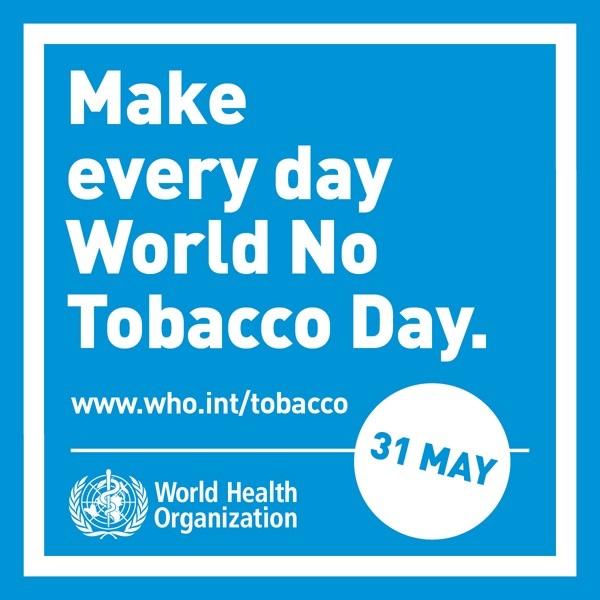Celebrate World No Tobacco Day 2019
, by Mark Parascandola & Michele Bloch
This year’s World No Tobacco Day, recognized on May 31, highlights the impact of smoking on lung health with the slogan “Don’t let tobacco take your breath away.” Tobacco smoking is a major cause of lung diseases worldwide, including lung cancer, COPD, pneumonia, and tuberculosis (TB). Indeed, the vast majority of global lung cancers, an estimated 80%, are attributable to tobacco smoking.
Tobacco-caused lung cancer is a leading contributor to the global burden of cancer. Lung cancer is the most commonly diagnosed cancer worldwide and the leading cause of overall cancer death, responsible for 11.6% of cancer cases and 18.4% of cancer deaths according to data from GLOBOCAN 2018. Among women, lung cancer remains the second most common cause of cancer death, following breast cancer. And five-year survival rates for lung cancer are very low (less than 20%) compared with other frequently diagnosed cancers.
The good news is that in countries, including the U.S., where efforts to reduce tobacco use have been in place over time, lung cancer is on the decline, along with other tobacco related diseases. According to estimates from the Surveillance, Epidemiology, and End Results (SEER) Program, supported by NCI, new cases of lung cancer have decreased from a rate of 67 per 100,000 persons in 1992 to 46.1 per 100,000 in 2016. The gains seen today against lung cancer follow decades of efforts at the local, state and national levels to implement policies and programs to reduce tobacco use, including significant tobacco tax and price increases, comprehensive smoke-free policies, hard-hitting anti-tobacco media campaigns, restrictions on sales to youth, and provision of tobacco dependence treatment. As a result, tobacco use prevalence in the U.S. has steadily decreased from 42% in 1966 to 14% in 2017 according to the latest Cancer Trends Progress Report.
On a global scale, tobacco control is critical to reducing the burden from lung cancer and other tobacco related diseases. However, while cigarette consumption has been decreasing steadily among high-income countries, that is not the case among many low- and middle-income countries. Today, over 80% of the world’s tobacco users live in low- and middle-income countries (LMICs). Thus, the burden of tobacco related disease will increasingly fall on LMICs, where resources and capacity for tobacco control may be limited.
Tobacco use continues to pose new challenges for science and public health, particularly in LMICs. NCI-funded researchers are exploring innovative strategies to strengthen tobacco control interventions in low resource settings, such as through using mobile health technology to reach tobacco users in rural areas or embedding tobacco dependence treatment into existing healthcare infrastructure. And WHO’s Practical Approach to Lung Health Strategy includes tobacco control as part of a comprehensive strategy to address lung health in primary care settings, built around TB control networks in LMICs. More such efforts are needed to continue to expand the reach of evidence-based tobacco control measures.
Because lung cancer develops slowly, over decades, it will take time to see the results of today’s novel interventions on global lung cancer patterns. However, without vigorous action to reduce tobacco use, the burden for cancer, and other diseases, will surely continue to grow into the future. Acting now to reduce tobacco use worldwide, particularly in LMICs, is critical to reducing the future global burden of lung cancer.
Selected NCI Tobacco Control Resources:
